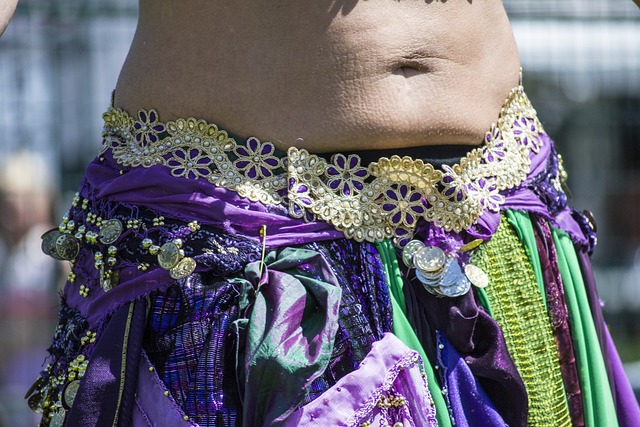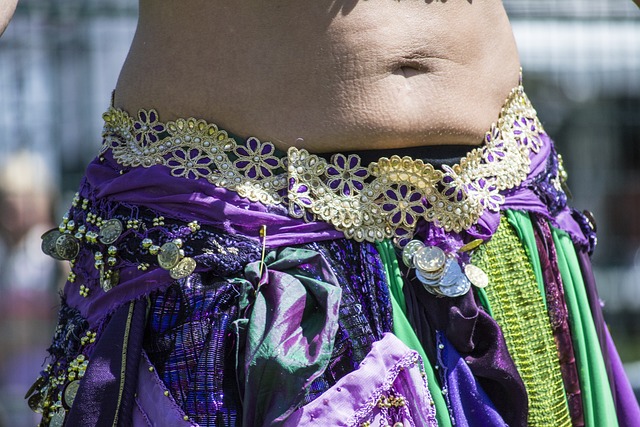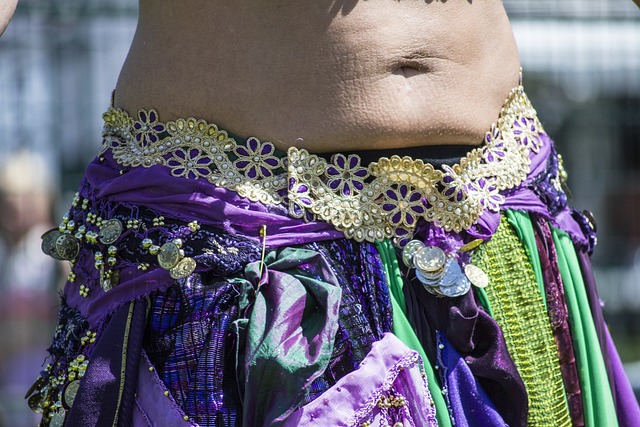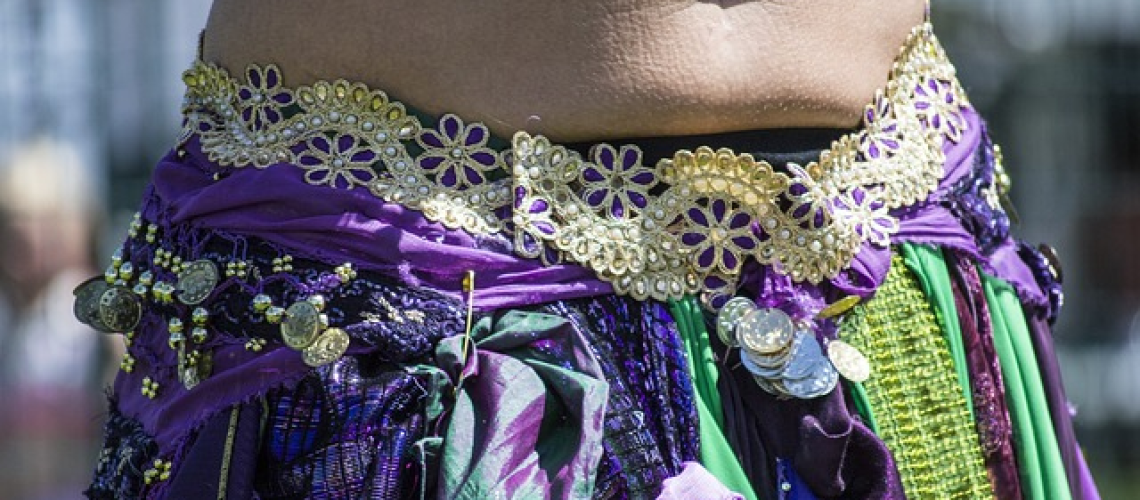In the realm of dance, there exists a mesmerizing form that captivates both the eye and the soul. Like a delicate silk scarf gracefully swirling through the air, Turkish belly dancing enchants its audience with its alluring beauty and intricate movements. Just as a skilled painter wields their brush to create a masterpiece, so too does the belly dancer use her body to paint an exquisite picture before our very eyes.
Originating from the depths of Anatolia’s rich cultural heritage, Turkish belly dancing traces its roots back centuries ago. As time passed, this art form evolved into a refined dance style characterized by its emphasis on fluidity and control. The techniques employed in Turkish belly dancing are diverse and complex, requiring years of practice to master.
Beyond its aesthetic allure, Turkish belly dancing holds profound cultural significance. It serves as a celebration of femininity, sensuality, and self-expression in Turkish society. Today, this ancient tradition continues to thrive in modern interpretations that pay homage to its historical legacy while embracing contemporary influences.
Through exploring the origin, history, techniques, and cultural significance of Turkish belly dancing in this article, we will unravel the intricacies of this enchanting art form. Join us on this journey as we delve into the world of Turkish belly dancing – where grace meets passion and tradition dances hand in hand with innovation.
Key Takeaways
- Turkish belly dancing originated from Anatolia’s rich cultural heritage and has evolved into a refined dance style characterized by fluidity and control.
- The techniques employed in Turkish belly dancing are diverse and complex, requiring years of practice to master.
- Turkish belly dancing serves as a celebration of femininity, sensuality, and self-expression in Turkish society.
- Turkish belly dancing traces its roots back to ancient civilizations in Mesopotamia and Egypt, incorporating influences from various regions such as North Africa, Persia, and Anatolia.
Origin and History of Turkish Belly Dancing

The origin and history of Turkish belly dancing can be traced back to ancient civilizations in Mesopotamia and Egypt, where it served as a form of ritualistic dance and fertility celebration. The origins of this captivating dance style are deeply rooted in the cultures of these ancient civilizations, with influences from various regions such as North Africa, Persia, and Anatolia.
The precise timeline of the development of Turkish belly dancing is difficult to determine due to its ancient roots. However, it is believed that the dance form began evolving around 6th century BC in Mesopotamia and later spread throughout the region. Over time, Turkish belly dancing incorporated elements from different cultures and adapted to local traditions.
Influences from Persia are evident in the graceful arm movements and intricate hand gestures often seen in Turkish belly dancing. The use of finger cymbals or zills is another characteristic unique to this dance form, which was likely influenced by Persian musical traditions.
Anatolian influence on Turkish belly dancing can be observed through its energetic footwork and lively movements. This region’s rich history of diverse cultural interactions played a significant role in shaping the dance style we see today.
Overall, the origins and influences of Turkish belly dancing reflect a long-standing tradition that has evolved over centuries through a blend of cultural exchanges and regional variations.
Techniques and Movements in Turkish Belly Dancing

This discussion will focus on the techniques and movements in Turkish belly dancing, specifically exploring the isolations of the hips and torso as well as the use of props such as veils and finger cymbals. Isolations in Turkish belly dancing involve precise control of individual body parts, allowing dancers to isolate and move their hips and torso with fluidity and precision. Additionally, props like veils are often incorporated into performances, adding an element of elegance and grace, while finger cymbals provide rhythmic accompaniment to the dance movements. Overall, these techniques and prop usage contribute to the intricate artistry of Turkish belly dancing.
Isolations of the hips and torso
Isolations of the hips and torso in Turkish belly dancing showcase a mesmerizing display of precise muscular control and fluid movements. This dance form emphasizes intricate hip movements that involve isolating different parts of the hips, such as the upper hips, lower hips, and glutes. These isolations create a visually striking effect as the dancer’s body moves in sync with the rhythm of the music. Additionally, belly rolls are another essential technique used in Turkish belly dancing. Belly rolls involve smoothly undulating the muscles of the abdomen to create a wave-like motion along the torso. The dancer’s ability to isolate and control these movements is crucial for creating a captivating performance that engages both the audience’s eyes and emotions.
- Upper hip isolations
- Lower hip isolations
- Glute isolations
- Smooth belly rolls
- Wave-like motion along the torso
Use of props such as veils and finger cymbals
Props such as veils and finger cymbals enhance the visual and auditory aspects of the dance performance, adding an additional layer of complexity and artistry to the overall presentation. Veil choreography in Turkish belly dancing involves graceful movements that accentuate the dancer’s body lines and create mesmerizing patterns in the air. The flowing nature of the veil allows for dramatic entrances and exits, creating a sense of mystery and allure. It also adds an element of elegance to the dance routine. On the other hand, finger cymbals, also known as Zills, produce rhythmic sounds that accompany the music. Dancers utilize various techniques to play these small cymbals while simultaneously performing intricate hip and torso isolations. This coordination between body movements and zill playing adds depth to the performance, captivating spectators with its synchronization and skillful execution.
| Pros | Cons | Tips |
|---|---|---|
| Enhances visual aspect | Requires practice for mastery | Start with simple veil movements |
| Adds auditory layer | May be distracting if overused | Incorporate zill techniques gradually |
| Creates sense of mystery | Veil may obstruct view at times | Use zills sparingly for impact |
| Elegance in movement | Finger cymbals require coordination | Experiment with different veil sizes |
| Synchronization with music | Zill playing may overpower music | Seek professional guidance for technique improvement |
Props such as veils and finger cymbals play a crucial role in Turkish belly dancing by enriching both visual aesthetics and auditory experience. Through well-choreographed veil movements and skilled manipulation of finger cymbals, dancers elevate their performances to new heights, captivating audiences with their artistic expression and technical prowess.
Cultural Significance and Modern Interpretations

Cultural significance and modern interpretations of Turkish belly dancing showcase a rich tapestry of artistic expression that captivates audiences with its mesmerizing fluidity, intricate footwork, and alluring sensuality.
- Evolution of Turkish Belly Dancing:
- Over the years, Turkish belly dancing has evolved from a traditional folk dance to a sophisticated form of entertainment. It has incorporated elements from various cultures, including Egyptian and Romani influences. This evolution has allowed for greater creativity and innovation within the dance style.
- The impact on body image:
- Turkish belly dancing celebrates diverse body types and promotes self-acceptance. Unlike Western beauty standards that prioritize thinness, this dance form embraces curves and encourages performers to feel confident in their bodies. By showcasing different body shapes, it challenges societal norms and fosters positive body image.
- Empowerment through movement:
- Turkish belly dancing empowers performers by allowing them to express themselves physically and emotionally. The rhythmic movements build strength, flexibility, and grace while also providing an outlet for personal expression. Through this dance form, individuals can explore their own identity, assert their femininity, and gain a sense of empowerment.
Cultural significance and modern interpretations of Turkish belly dancing have not only shaped the evolution of the art form but also had a profound impact on body image perceptions and empowerment. It continues to be an intimate art form that invites audiences to appreciate its beauty while celebrating diversity in both movement styles and bodies.
Frequently Asked Questions
What are the different types of costumes worn in Turkish belly dancing?
Types of belly dancing costumes in Turkish tradition include the bedlah, a two-piece ensemble with a bra top and skirt, and the çatal, a costume featuring wide pants. Traditional Turkish attire holds cultural significance by preserving artistic heritage.
Are there any specific rules or etiquette that should be followed when watching a Turkish belly dancing performance?
Proper audience behavior during a Turkish belly dancing performance involves respectful attentiveness and refraining from inappropriate comments or actions. Turkish belly dancing holds cultural significance as it embodies femininity, sensuality, and spirituality through intricate movements, costumes, and music.
How long does it typically take to learn Turkish belly dancing?
The time commitment to learn Turkish belly dancing varies depending on individual factors such as natural talent, previous dance experience, and practice frequency. However, it is generally recommended to have a regular practice schedule of at least several hours per week.
Are there any health benefits associated with practicing Turkish belly dancing?
Practicing Turkish belly dancing has various health benefits. It improves flexibility, strengthens core muscles, and enhances posture. Additionally, it promotes cardiovascular endurance and provides a form of stress relief. The cultural significance of this dance form adds to its appeal.
Is Turkish belly dancing only performed by women, or are men also involved in this dance form?
Men are not typically involved in Turkish belly dancing. This dance form is predominantly performed by women and holds cultural significance in Turkey, representing femininity, sensuality, and the celebration of womanhood.
